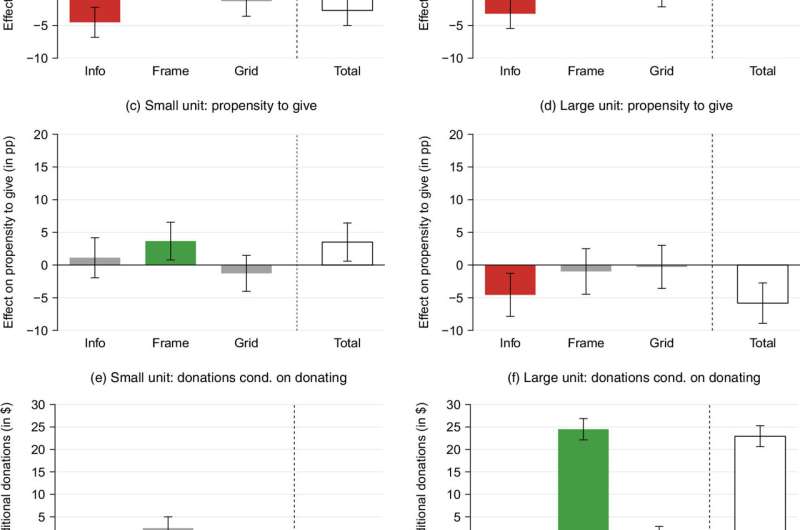This article has been reviewed according to Science X's editorial process and policies. Editors have highlighted the following attributes while ensuring the content's credibility:
fact-checked
peer-reviewed publication
trusted source
proofread
Fundraising: Higher donation returns when asking for units of relief supplies rather than money

Small changes in how potential donors are approached can achieve significantly higher donation returns than the classic tactic of asking for monetary donations. This is the conclusion of an online survey conducted by behavioral economists from the universities of Heidelberg, Innsbruck (Austria) and Kassel.
In the study, potential donors were asked if they wanted to donate relief supplies at a specified unit price and, if so, how many. This resulted in an increase in donation income of more than 50%. However, this alternative approach requires careful selection of the units—otherwise, it can also lead to losses in fundraising.
When charitable organizations seek public support, they usually ask, "How many Euros would you like to donate?" Sometimes, however, potential donors are asked how many units of a relief item—be it blankets, water pumps or daily rations of baby formula—they would like to donate at a certain unit price.
This seemingly small difference in the question can, under certain conditions, have a major impact on how people donate. The research was conducted by Prof. Timo Goeschl, Ph.D. (Heidelberg), Dr. Raphael Epperson (Innsbruck) and Dr. Johannes Diederich (Kassel) and published in Management Science.
About 8,700 crowd workers had the opportunity to donate part or all of their remuneration for online work to a relief organization—either as a purely monetary donation or by funding units of relief supplies. Before making their decision, the donors were all informed that the money was intended for ready-to-use therapeutic food rations for children in developing countries.
When comparing the unit and monetary donation systems, the study found that the most successful unit campaign achieved 57% higher donation returns than the classic monetary donation campaign.
According to the researchers, the reason for the differences in donation behavior is not that the potential donors are more informed about the actual costs of the relief supplies. Rather, the ask in terms of units leads donors to focus more on the effectiveness of their donation and leverages well-known behavioral biases.
At the same time, the unit at the center of a campaign must be chosen wisely. The request to donate monthly rations of special foods for 30 dollars each deterred more donors in the study than the unit of a daily ration for one dollar. But ultimately it still led to higher donations.
"Unit donations can be an attractive alternative to the usual monetary donations. However, they must be framed in the right way to achieve strategic goals such as increasing the total donation amount or expanding the donor base," says Timo Goeschl, Professor of Economics at the Alfred Weber Institute for Economics at Heidelberg University and one of the co-authors of the study.
"The recent studies corroborate our previous research: Fundraising with donation units has great potential, but only for prudent fundraisers."
The results of the study are therefore directly relevant to managers in the charitable sector as well as donation officers and fundraisers. "The scale of the effects definitely justifies thinking about this format," says Johannes Diederich, who conducts research in the field of environmental and behavioral economics at the University of Kassel.
But they also make an important contribution to the field of philanthropic studies, which asks how selfless behavior is justified.
"The study provides new insights into individuals' donation behavior and behavioral economic mechanisms in fundraising," says Raphael Epperson from the Department of Public Finance at the University of Innsbruck.
More information: Raphael Epperson et al, How to Design the Ask? Funding Units vs. Giving Money, Management Science (2024). DOI: 10.1287/mnsc.2021.00157
Journal information: Management Science
Provided by Heidelberg University





















